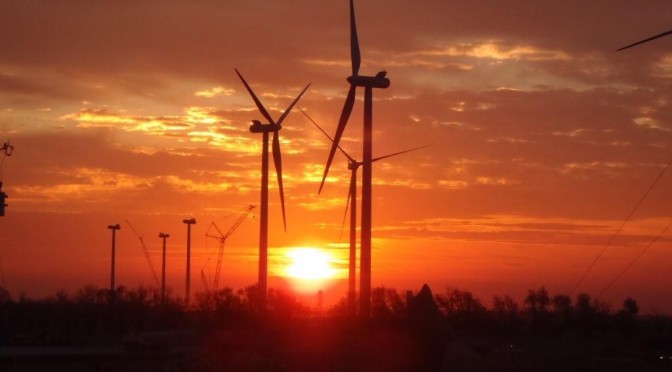Overall, by 2015, Latin America should begin to install over 3 GW wind on an annual basis, eventually reaching 4.3 GW annually by 2022.
The total amount of wind power capacity projected to be installed from 2014 to 2022 is almost 31.5 GW.
The global wind industry added 36,134 MW in 2013, the first time in eight years that the wind power industry has installed less in a given year than the year before. The size of the annual market declined 20 percent year on year in 2013, compared to market growth of 18.6 percent in 2012. The market decline was not unexpected. Negative conditions in several key countries, particularly the U.S. and Spain, were a drag on market growth. The U.S. will recover through the 2014-2015 cycle with over 12 GW expected, but Spain, once a pillar of the global wind market, will languish following a collapse of its renewables policies.
This backdrop highlights the importance of a diversified global wind energy market, and Latin America, in particular, has provided an important alternative growth market for the wind energy industry. As a whole, Latin America represents a mere 10 percent of the 77.1 GW of installed capacity in North and South America combined. The U.S. alone represents 60.2 GW. However, in 2013, Latin America represented just over 2 GW or 43.3 percent of the 4.7 GW installed last year, driven primarily by Brazil and Mexico.
Brazil’s power contract auctions are continuing to drive the country’s wind market. In 2013, Brazil brought 948 MW of new wind plants online, just down from the 1,077 MW installed in 2012. Cumulative capacity reached 3,869 MW by the end of the year, a growth rate of 32.4 percent from the 2,921 MW total capacity online at the end of 2012. The country’s wind growth is fuelled by its power contract auctions. Since 2009, there have been 11 auction rounds, with over 13.2 GW of wind power contracts awarded.
The power contracts are a double-edge sword. Average price across all auction rounds is BRL120.5/MWh ($49.5/MWh), which enables wind to compete with fossil fuel plants. However, these low contract rates force slim profit margins for wind developers and wind turbine OEMs. Most wind plant in Brazil secure low interest CAPEX financing from the country’s development bank, BNDES. This, too, is double-edged since to qualify for BNDES funding, wind plants have to meet specific local content mandates requiring wind turbine components and materials to be manufactured in Brazil. This challenge is aggravated by high number of OEMs competing and limited sub-component manufacturers.
The top three turbine suppliers in Brazil in 2013 were GE (25 percent), Gamesa (20 percent), and Vestas (19 percent). This is the first year GE topped other OEMs in Brazil, and a clear example of the U.S. company using Brazil to offset what was otherwise a bleak year in the U.S. Gamesa has traditionally been well represented in Latin America, but the collapse of the wind market in the OEM’s home market of Spain underlines the importance for Gamesa to increase business in Latin America.
Mexico installed 476 MW of new wind capacity in 2013, a 22.3 percent increase on the 389 MW installed in 2012. Cumulative capacity reached 1,988 MW by the end of the year, representing a growth rate of 31.4 percent. A number of factors, including strong wind resources, high electricity prices, and robust energy demand drive Mexico’s market. A few key policies tailored to large industrial users are also proving effective. This includes a 100 percent first-year accelerated depreciation tax policy and the so-called self-supply (autobastemiento) scheme. This allows large industrial end-users of electricity to partner with wind developers to build wind plants to offset a company’s energy usage. Wind plants do not have to be located near the end user’s facilities but simply have to connect to the Mexican grid. Under NAFTA, companies exporting to Mexico from the U.S. or Canada avoid a 15percent import duty—providing a relief valve or secondary market for wind manufacturing facilities in North America.
New energy policy reforms announced in late 2013 are set to end state-owned monopoly rule of the electricity sector. This is a wild card for the wind market. Details of how this will be structured are being drafted this year and will ultimately determine if the strong momentum in Mexico’s wind sector continues. If a truly competitive electricity market open to private investment results in slashing energy prices, wind plants may be at a new cost disadvantage with few financial incentives to lean on. Gamesa was by far the leading turbine supplier in Mexico last year, accounting for 73.5 percent of the market, followed by Vestas (22 percent) and GE (4.5 percent).
While Brazil and Mexico are the twin pillars of the Latin American market, others cannot be ignored. In 2013, Argentina installed 76 MW of wind plants, thanks to support from its GENREN program. Chile added 200 MW, nearly doubling its cumulative installed wind capacity to 413 MW. There are few government subsidy incentives in Chile, but high electricity prices and high energy demand is driving growth. In Peru, 30 MW of new wind capacity was installed, while the rights to develop a further 232 MW were awarded via two government tenders. Despite political upheaval, Venezuela installed 149 MW in 2013. Uruguay installed just 11 MW last year, but a series of government-sponsored power contract auctions mean it is poised to reach triple-digit growth rates, potentially installing over 1 GW between 2015 and 2017.
Further data and analysis of the Latin America and global wind markets is available through the following Navigant Research reports: Latin America Wind Market Assessment and World Market Update 2013 – International Wind Energy Development, Forecast 2014-2018.


